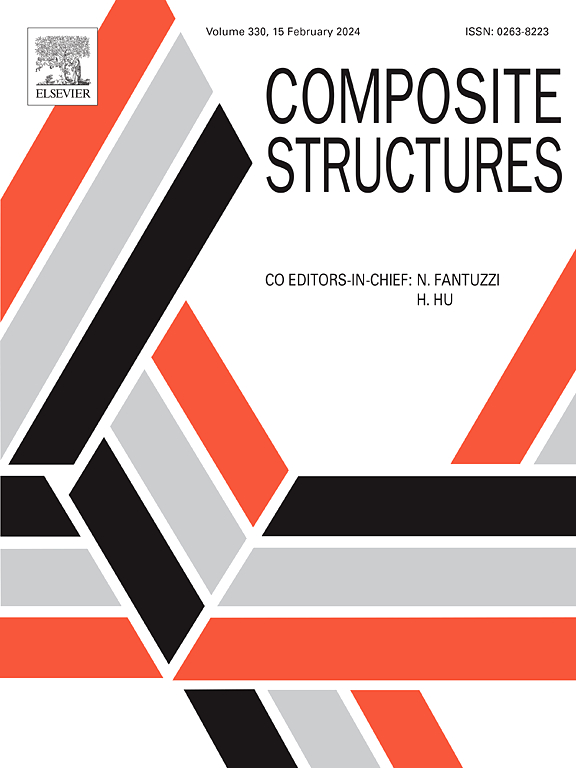基于有限元模型的各种柔性导向三维编织工艺结构拉伸疲劳寿命比较研究
IF 6.3
2区 材料科学
Q1 MATERIALS SCIENCE, COMPOSITES
引用次数: 0
摘要
为了比较研究各种三维(3D)结构的拉伸疲劳寿命,设计并制造了三维正交编织复合材料(3DOWC)、离轴三维正交编织复合材料(OA-3DOWC)和多轴三维编织复合材料(M3DWC)。研究人员进行了拉伸和疲劳试验,并利用微计算机断层扫描(Micro-CT)技术观察了中尺度结构特征和疲劳断裂形态。根据观察结果建立了有限元模型。然后使用修正的幂律疲劳损伤模型来降低疲劳加载过程中的刚度和强度,并使用归一化寿命模型来预测不同应力水平下的疲劳寿命。与现有模型进行比较,分析其预测精度。结果表明,与 3DOWC 相比,M3DWC 的抗拉强度降低了 54.6%,而其疲劳性能却有了显著改善。此外,与 3DOWC 相比,OA-3DOWC 的抗拉强度最差,但疲劳性能略有改善。疲劳寿命的预测结果与实验结果之间的最大误差为 11.16%。在相同应力水平下的疲劳寿命方面,M3DWC > OA-3DOWC > 3DOWC 由于交错纤维排列的裂纹扩展路径复杂。本文章由计算机程序翻译,如有差异,请以英文原文为准。
A comparative study of tensile fatigue life in various flexible-oriented three-dimensional woven process structures based on finite element models
To achieve a comparative study of tensile fatigue life in various three-dimensional (3D) structures, 3D orthogonal woven composite (3DOWC), off-axis 3D orthogonal woven composite (OA-3DOWC) and multiaxial 3D woven composite (M3DWC), were designed and manufactured. Tensile and fatigue tests were performed, and microcomputed tomography (Micro-CT) was utilized to observe the mesoscale structural characteristics and the fatigue fracture morphology. Finite element models were established based on the observation. Then a modified power-law fatigue damage model was used for reduction of stiffness and strength during fatigue loading process, and a normalized life model was used to predict the fatigue life at different stress levels. Comparisons were conducted with existing models to analyze their predictive accuracy. Results showed that the tensile strength of M3DWC decreased by 54.6 % compared to 3DOWC, while its fatigue performance of M3DWC was significantly improved. Additionally, OA-3DOWC had the worst tensile strength but slightly improved fatigue performance compared to 3DOWC. And for the maximum error between the prediction and experimental results for the fatigue life is 11.16 %. For the fatigue life at the same stress level, M3DWC > OA-3DOWC > 3DOWC, due to the complex crack propagation paths in the staggered fiber arrangement.
求助全文
通过发布文献求助,成功后即可免费获取论文全文。
去求助
来源期刊

Composite Structures
工程技术-材料科学:复合
CiteScore
12.00
自引率
12.70%
发文量
1246
审稿时长
78 days
期刊介绍:
The past few decades have seen outstanding advances in the use of composite materials in structural applications. There can be little doubt that, within engineering circles, composites have revolutionised traditional design concepts and made possible an unparalleled range of new and exciting possibilities as viable materials for construction. Composite Structures, an International Journal, disseminates knowledge between users, manufacturers, designers and researchers involved in structures or structural components manufactured using composite materials.
The journal publishes papers which contribute to knowledge in the use of composite materials in engineering structures. Papers deal with design, research and development studies, experimental investigations, theoretical analysis and fabrication techniques relevant to the application of composites in load-bearing components for assemblies, ranging from individual components such as plates and shells to complete composite structures.
 求助内容:
求助内容: 应助结果提醒方式:
应助结果提醒方式:


